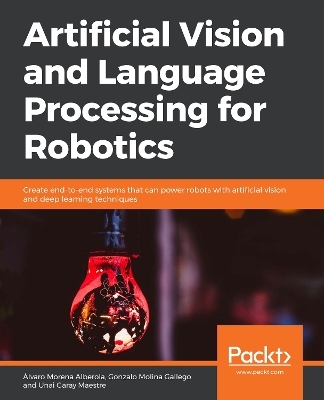
Artificial Vision and Language Processing for Robotics
Packt Publishing Limited (Verlag)
978-1-83855-226-8 (ISBN)
Create end-to-end systems that can power robots with artificial vision and deep learning techniques
Key Features
Study ROS, the main development framework for robotics, in detail
Learn all about convolutional neural networks, recurrent neural networks, and robotics
Create a chatbot to interact with the robot
Book DescriptionArtificial Vision and Language Processing for Robotics begins by discussing the theory behind robots. You'll compare different methods used to work with robots and explore computer vision, its algorithms, and limits. You'll then learn how to control the robot with natural language processing commands. You'll study Word2Vec and GloVe embedding techniques, non-numeric data, recurrent neural network (RNNs), and their advanced models. You'll create a simple Word2Vec model with Keras, as well as build a convolutional neural network (CNN) and improve it with data augmentation and transfer learning. You'll study the ROS and build a conversational agent to manage your robot. You'll also integrate your agent with the ROS and convert an image to text and text to speech. You'll learn to build an object recognition system using a video.
By the end of this book, you'll have the skills you need to build a functional application that can integrate with a ROS to extract useful information about your environment.
What you will learn
Explore the ROS and build a basic robotic system
Understand the architecture of neural networks
Identify conversation intents with NLP techniques
Learn and use the embedding with Word2Vec and GloVe
Build a basic CNN and improve it using generative models
Use deep learning to implement artificial intelligence(AI)and object recognition
Develop a simple object recognition system using CNNs
Integrate AI with ROS to enable your robot to recognize objects
Who this book is forArtificial Vision and Language Processing for Robotics is for robotics engineers who want to learn how to integrate computer vision and deep learning techniques to create complete robotic systems. It will prove beneficial to you if you have working knowledge of Python and a background in deep learning. Knowledge of the ROS is a plus.
Álvaro Morena Alberola is a computer engineer and loves robotics and artificial intelligence. Currently, he is working as a software developer. He is extremely interested in the core part of AI, which is based on artificial vision. Álvaro likes working with new technologies and learning how to use advanced tools. He perceives robotics as a way of easing human lives; a way of helping people perform tasks that they cannot do on their own. Gonzalo Molina Gallego is a computer science graduate and specializes in artificial intelligence and natural language processing. He has experience of working on text-based dialog systems, creating conversational agents, and advising good methodologies. Currently, he is researching new techniques on hybrid-domain conversational systems. Gonzalo thinks that conversational user interfaces are the future. Unai Garay Maestre is a computer science graduate and specializes in the field of artificial intelligence and computer vision. He successfully contributed to the CIARP conference of 2018 with a paper that takes a new approach to data augmentation using variational autoencoders. He also works as a machine learning developer using deep neural networks applied to images.
Table of Contents
Fundamentals of Robotics
Introduction to Computer Vision
Fundamentals of Natural Language Processing
Neural Networks with NLP
Convolutional Neural Networks
Robot Operating System
Build a Conventional Agent to Manage the Robot
Object Recognition to Guide a Robot Using CNNs
Computer Vision for Robotics
| Erscheinungsdatum | 07.05.2019 |
|---|---|
| Verlagsort | Birmingham |
| Sprache | englisch |
| Maße | 75 x 93 mm |
| Themenwelt | Mathematik / Informatik ► Informatik ► Programmiersprachen / -werkzeuge |
| Informatik ► Theorie / Studium ► Künstliche Intelligenz / Robotik | |
| ISBN-10 | 1-83855-226-X / 183855226X |
| ISBN-13 | 978-1-83855-226-8 / 9781838552268 |
| Zustand | Neuware |
| Haben Sie eine Frage zum Produkt? |
aus dem Bereich


